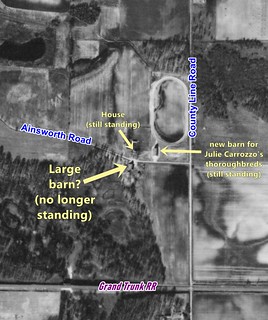
(Click on image to enlarge)
Image courtesy of Eldon Harms.
The photographer is standing on Ainsworth Road just west of County Line road and pointing the camera south(west), toward the big barn on the farm the Thompson family rented.
There are four horses, two men, a woman, and two dogs. The photo isn't clear enough to identify anyone, although, to me, the woman looks vaguely like Nancy Thompson.
There is no date. I'm guessing, very roughly, at the early to mid-1920s.
As for the machine, here are the notes I took as Eldon Harms told me about it:
The machine is a binder. The rotating arms with horizontal planks knock the grain against the sickle bar at the bottom to cut it. It cuts wheat/oats and binds bundles of grain (ties it up themselves), continues filling up with bundles to a set number, at which point it drops them all at once so you can shock them. Grain is left to dry and cure (maybe days or weeks); then you gather all your bundles and haul them to one place to be threshed. How to tell if grain ready for threshing? You can rub it on your hand to see how dry it is. Some guys chewed on a grain to judge.
If the big barn was still standing in 1939 (at which time the land was owned by Michael and Julie Carrozzo), we can tell where it stood from the aerial photo of that time.

(Click on image to enlarge)
Photo from https://igws.indiana.edu/IHAPI/.







